Evaluation of LNAPL Behavior in Water Table Inter-Fluctuate Zone under Groundwater Drawdown Condition
Abstract
:1. Introduction
2. Material and Methods
2.1. Tank Description
2.2. Aquifer Material
2.3. LNAPL Properties
2.4. Injection of LNAPLs
3. Experiments
3.1. Experiment E1: Coarse Grain, Gas Oil
3.2. Experiment E2: Coarse Grain, Crude Oil
3.3. Experiment E3: Fine Grain, Gas Oil
4. Discussion
5. Conclusions
Author Contributions
Funding
Conflicts of Interest
References
- ASTM E2531-06(2014). In Standard Guide for Development of Conceptual Site Models and Remediation Strategies for Light Nonaqueous-Phase Liquids Released to the Subsurface; ASTM International: West Conshohocken, PA, USA, 2014.
- CL: AIRE. An Illustrated Handbook of Lnapl Transport and Fate in the Subsurface; CL: AIRE: London, UK, 2014; ISBN 978-1-905046-24-9. [Google Scholar]
- Fetter, C.W.; Thomas, B.; Boving, T.B.; Kreamer, D. Contaminant Hydrogeology, 3rd ed.; Waveland Press: Long Grove, IL, USA, 1997; 647p. [Google Scholar]
- Lenhard, R.J.; Sookhak Lari, K.; Rayner, J.L.; Davis, G.B. Evaluating an Analytical Model to Predict Subsurface LNAPL Distributions and Transmissivity from Current and Historic Fluid Levels in Groundwater Wells: Comparing Results to Numerical Simulations. Groundw. Monitor. Remed. 2018, 38, 75–84. [Google Scholar] [CrossRef] [Green Version]
- US EPA. A Decision-Making Framework for Cleanup of Sites Impacted with Light Non-Aqueous Phase Liquids (LNAPL). EPA 542-R-04-011. 2004. Available online: https://www.epa.gov/remedytech/decisionmaking-framework-cleanup-sites-impacted-light-non-aqueousphase-liquids-lnapl (accessed on 15 June 2020).
- CRC CARE. A Practitioner’s Guide for the Analysis, Management and Remediation of LNAPL; CRC CARE Technical Report 34; CRC for Contamination Assessment and Remediation of the Environment: Adelaide, Australia, 2015. [Google Scholar]
- Atteia, O.; Palmier, C.; Schäfer, G. On the influence of groundwater table fluctuations on oil thickness in a well related to an LNAPL contaminated aquifer. J. Contam. Hydrol. 2019, 223, 103476. [Google Scholar] [CrossRef] [PubMed]
- Gatsios, E.; García-Rincón, J.; Rayner, J.L.; McLaughlan, R.G.; Davis, G.B. LNAPL transmissivity as a remediation metric in complex sites under water table fluctuations. J. Environ. Manag. 2018, 215, 40–48. [Google Scholar] [CrossRef] [PubMed]
- Lenhard, R.J.; Rayner, J.L.; Davis, G.B. A practical tool for estimating subsurface LNAPL distributions and transmissivity using current and historical fluid levels in groundwater wells: Effects of entrapped and residual LNAPL. J. Contam. Hydrol. 2017, 205, 1–11. [Google Scholar] [CrossRef] [PubMed]
- Kemblowski, M.W.; Chiang, C.Y. Hydrocarbon Thickness Fluctuations in Monitoring Wells. Ground Water 1990, 28, 244–252. [Google Scholar] [CrossRef]
- Ballestero, T.P.; Fiedler, F.R.; Kinner, N.E. An investigation of the relationship between actual and apparent gasoline thickness in a uniform sand aquifer. Ground Water 1994, 32, 708–718. [Google Scholar] [CrossRef]
- De Pastrovich, T.L.; Baradat, Y.; Barthel, R.; Chiarelli, A.; Fussell, D.R. Protection of groundwater from oil pollution. In CONCAWE Report 3/79; CONCAWE: The Hague, The Netherlands, 1979; p. 61. [Google Scholar]
- Hall, R.A.; Blake, S.B.; Champlin, S.C., Jr. Determination of hydrocarbon thicknesses in sediments using borehole data. In The Fourth National Symposium and Exposition on Aquifer Restoration and Ground Water Monitoring; National Ground Water Association: Dublin, OH, USA, 1984; pp. 300–304. [Google Scholar]
- Hampton, D.R.; Miller, P.D.G. Laboratory Investigation of the Relationship between Actual and Apparent Product Thickness in Sands; National Ground Water Association: Dublin, OH, USA, 1988; pp. 157–181. [Google Scholar]
- Schwille, F. Petroleum contamination of the subsoil: A hydrological problem. In The Joint Problems of the Oil and Water Industries: Proceedings of a Symposium Held at the Hotel Metropole, Brighton, UK, 18–20 January 1967; Institute of Petroleum: London, UK, 1967; pp. 23–54. [Google Scholar]
- Van Dam, J. The migration of hydrocarbons in a water-bearing stratum. In The Joint Problems of the Oil and Water Industries: Proceedings of a Symposium; Institute of Petroleum: London, UK, 1967; pp. 55–96. [Google Scholar]
- Zilliox, L.; Muntzer, P. Effects of hydrodynamic processes on the development of ground-water pollution: Study on physical models in a saturated porous medium. Prog. Water Technol. 1975, 7, 561–568. [Google Scholar]
- Farr, A.M.; Houghtalen, R.J.; McWhorter, D.B. Volume estimation of light nonaqueous phase liquids in porous media. Ground Water 1990, 28, 48–56. [Google Scholar] [CrossRef]
- Lenhard, R.J.; Parker, J.C. Estimation of free hydrocarbon volume from fluid levels in monitoring wells. Ground Water 1990, 28, 57–67. [Google Scholar] [CrossRef]
- Parker, J.C.; Lenhard, R.J.; Kuppusamy, T. A parametric model for constitutive properties governing multiphase flow in porous media. Water Resour. Res. 1987, 23, 618–624. [Google Scholar] [CrossRef]
- Parker, J.C.; Lenhard, R.J. Vertical integration of three-phase flow equations for analysis of light hydrocarbon plume movement. Trans. Porous Media 1989, 5, 187–206. [Google Scholar] [CrossRef]
- Parker, J.C.; Lenhard, R.J. A model for hysteretic constitutive relations governing multiphase flow. 1. Saturation-pressure relations. Water Resour. Res. 1987, 23, 2187–2196. [Google Scholar] [CrossRef]
- Lenhard, R.J.; Parker, J.C. A model for hysteretic constitutive relations governing multiphase flow. 2. Permeability-saturation relations. Water Resour. Res. 1987, 23, 2197–2206. [Google Scholar] [CrossRef]
- Parker, J.C.; Kaluarachchi, J.J.; Kremesec, V.J.; Hockman, E.L. Modeling free product recovery at hydrocarbon spill sites. In Conference Petroleum Hydrocarbons and Organic Chemicals in Ground Water: Prevention, Detection and Restoration; National Water Well Association: Dublin, OH, USA, 1990; pp. 641–655. [Google Scholar]
- Parker, J.C.; Zhu, J.L.; Johnson, T.G.; Kremesec, V.J.; Hockman, E.L. Modeling free product migration and recovery at hydrocarbon spill sites. Ground Water 1994, 32, 119–128. [Google Scholar] [CrossRef]
- Waddill, D.W.; Parker, J.C. Simulated recovery of light, nonaqueous phase liquid from unconfined heterogeneous aquifers. Ground Water 1997, 35, 938–947. [Google Scholar] [CrossRef]
- Lenhard, R.J.; Oostrom, M.; Dane, J.H. A constitutive model for air-NAPL-water flow in the vadose zone accounting for immobile, non-occluded (residual) NAPL in strongly water-wet porous media. J. Contam. Hydrol. 2004, 73, 283–304. [Google Scholar] [CrossRef]
- Charbeneau, R.J. LNAPL distribution and recovery model (LDRM). In Volume 1: Distribution and Recovery of Petroleum Hydrocarbon Liquids in Porous Media; API Publ. No. 4760; American Petroleum Institute: Washington, DC, USA, 2007. [Google Scholar]
- Charbeneau, R.J.; Johns, R.T.; Lake, R.W.; McAdams, M.J. Free-product recovery of petroleum hydrocarbon liquids. Ground. Water Monit. Rem. 2000, 20, 147–158. [Google Scholar] [CrossRef]
- Jeong, J.; Charbeneau, R.J. An analytical model for predicting LNAPL distribution and recovery from multi-layered soils. J. Contam. Hydrol. 2014, 156, 52–61. [Google Scholar] [CrossRef]
- Aral, M.M.; Liao, B. Effect of groundwater table fluctuations on LNAPL thickness in monitoring wells. Environ. Geol. 2002, 42, 151–161. [Google Scholar] [CrossRef]
- Deska, I.; Ociepa, E. Impact of the Water Table Fluctuations on the Apparent Thickness of Light Non-Aqueous Phase Liquids. Ecol. Chem. Eng. A 2013, 20, 771–778. [Google Scholar]
- Johnston, C.D.; Adamski, M. Relationship between Initial and Residual LNAPL Saturation for Different Soil Types; National Ground Water Association: Dublin, OH, USA, 2005; pp. 29–42. [Google Scholar]
- Lenhard, R.J.; Parker, J.C. Measurement and prediction of saturation-pressure relationships in three phase-porous media systems. J. Contam. Hydrol. 1987, 1, 407–424. [Google Scholar] [CrossRef]
- Liao, B.; Aral, M. Interpretation of LNAPL Thickness Measurements Under Unsteady Conditions. J. Hydrol. Eng. 1999, 4, 125–134. [Google Scholar] [CrossRef]
- Marinelli, F.; Durnford, D.S. LNAPL thickness in monitoring wells considering hysteresis and entrapment. Ground Water 1996, 34, 405–414. [Google Scholar] [CrossRef]
- Rayner, J.L.; Johnston, C.D.; Rao, P.S.C. Characterising residual NAPL using partitioning and interfacial tracers and implications for interphase mass transfer. In Contaminated Site Remediation: From Source Zones to Ecosystems, Proceedings of the 2000 Contaminated Site Remediation Conference, Melbourne, Australia, 4–8 December 2000; Johnston, C.D., Ed.; CSIRO Land and Water: Wembley, Australia, 2000; pp. 613–620. [Google Scholar]
- Steffy, D.A.; Johnston, C.D.; Barry, D.A. A field study of the vertical immiscible displacement of LNAPL associated with a fluctuating water table. In Groundwater Quality: Remediation and Protection; IAHS: Wallingford, UK, 1995; pp. 49–57. [Google Scholar]
- Steffy, D.A.; Johnston, C.D.; Barry, D.A. Numerical simulations and long-column tests of LNAPL displacement and trapping by a fluctuating water table. J. Soil Contam. 1998, 7, 325–356. [Google Scholar] [CrossRef]
- Vaezihir, A.; Bayanlou, M.B.; Ahmadnezhad, Z.; Barzegari, G. Remediation of BTEX plume in a continuous flow model using zeolite-PRB. J. Contam. Hydrol. 2020, 230, 103604. [Google Scholar] [CrossRef]
- Matos de Souza, M.; Oostrom, M.; White, M.D.; da Silva, G.C., Jr.; Barbosa, M.C. Simulation of subsurface multiphase contaminant extraction using a bioslurping well model. Trans. Porous Media 2016, 114, 649–673. [Google Scholar] [CrossRef]
- Sookhak Lari, K.; Johnston, C.D.; Davis, G.B. Gasoline multi-phase and multicomponent partitioning in the vadose zone: Dynamics and risk longevity. Vadose Zone J. 2016, 15. [Google Scholar] [CrossRef]
- White, M.D.; Oostrom, M.; Lenhard, R.J. Apractical model for mobile, residual and entrapped NAPL in water-wet porous media. Ground Water 2004, 42, 734–746. [Google Scholar] [CrossRef]
- Berardi, M.; Andrisani, A.; Lopez, L.; Vurro, M. A new data assimilation technique based on ememble Kalman filter and Brownian bridges: An application to Richards’ equation. Comput. Phys. Commun. 2016, 208, 43–53. [Google Scholar] [CrossRef]
- Zhang, Q.; Shi, L.; Holzman, M.; Ye, M.; Wang, Y.; Carmona, F.; Zha, Y. A dynamic data-driven method for dealing with model structural error in soil moisture data assimilation. Adv. Water Resour. 2019, 132, 103407. [Google Scholar] [CrossRef]
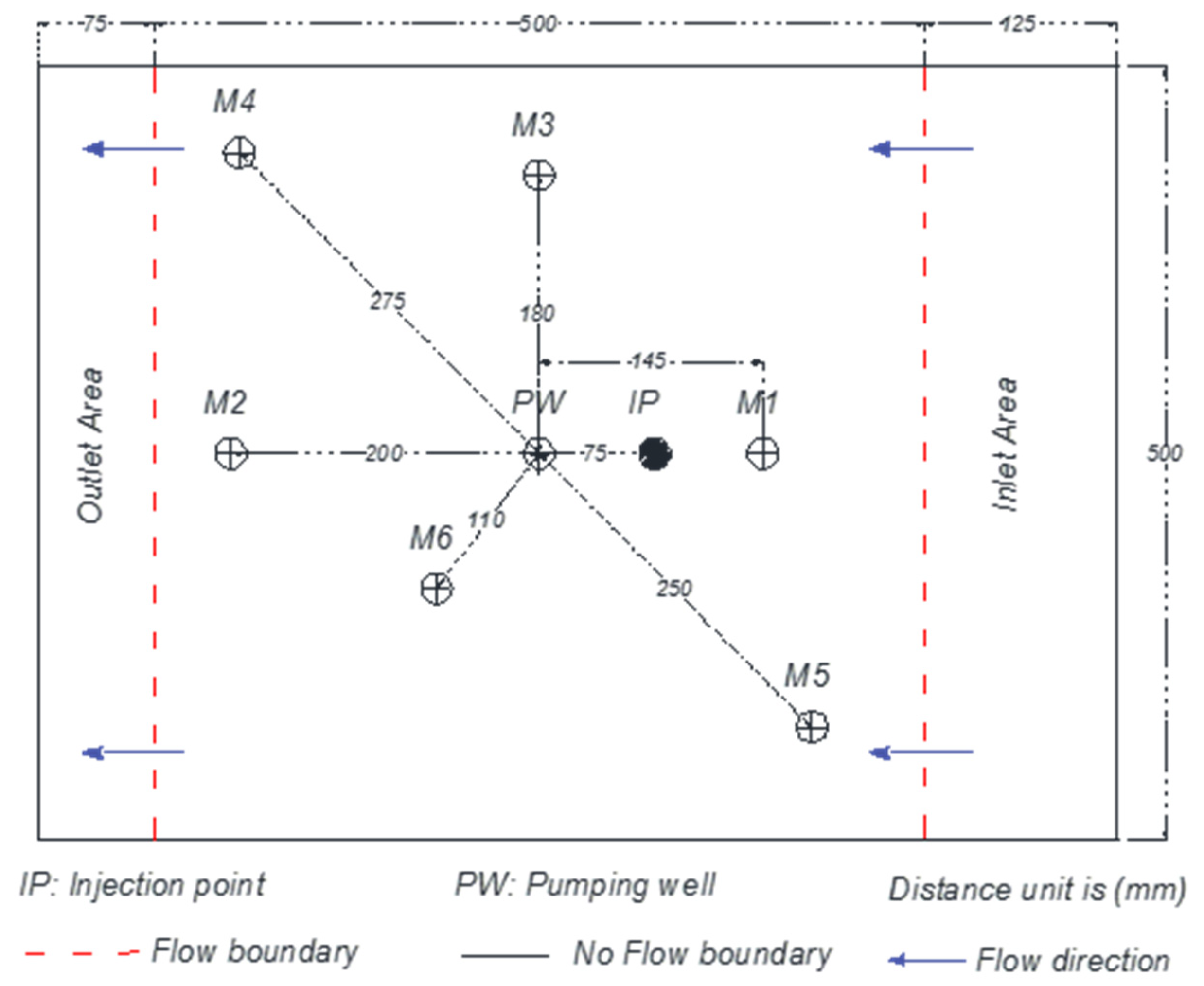
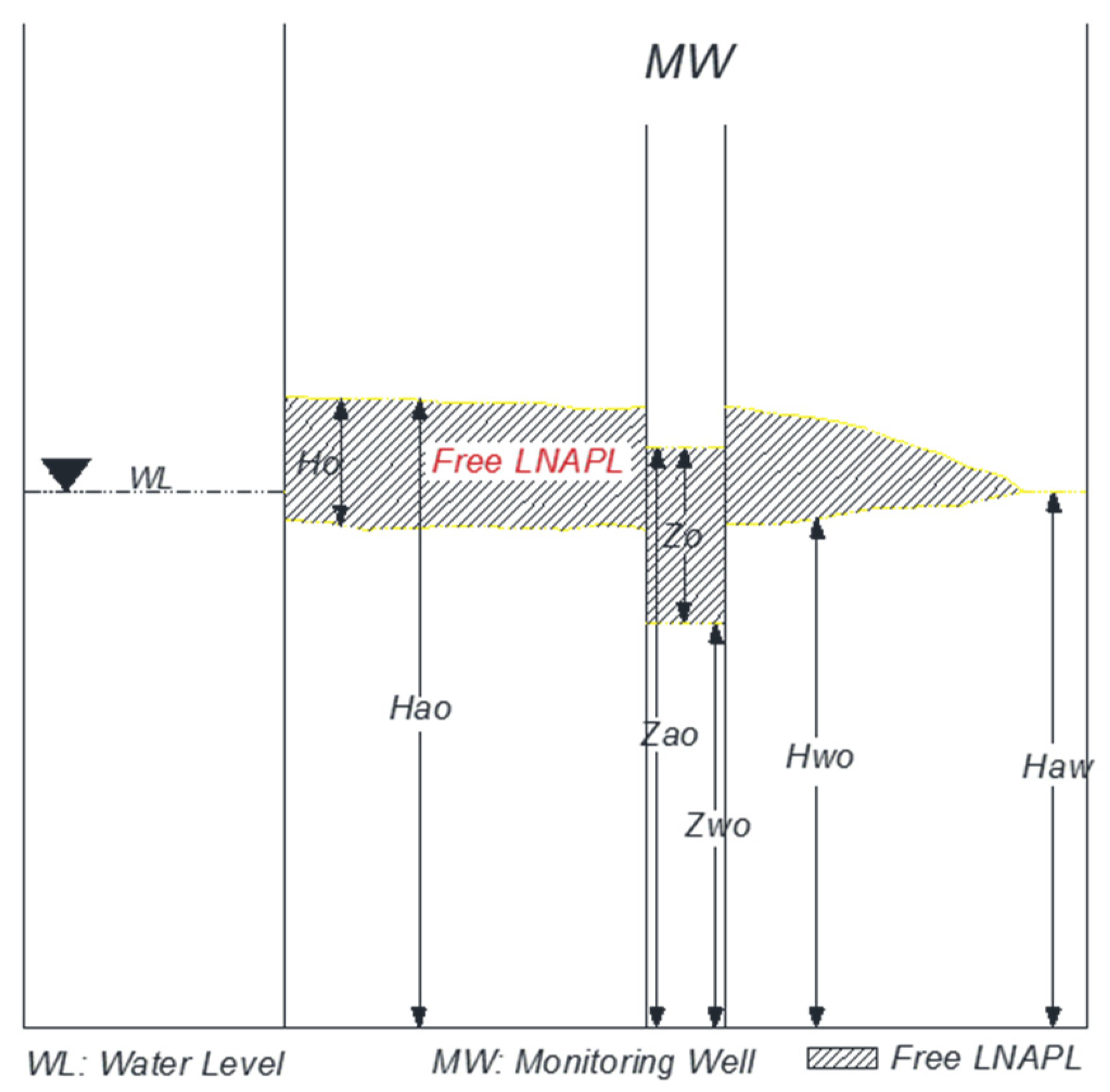
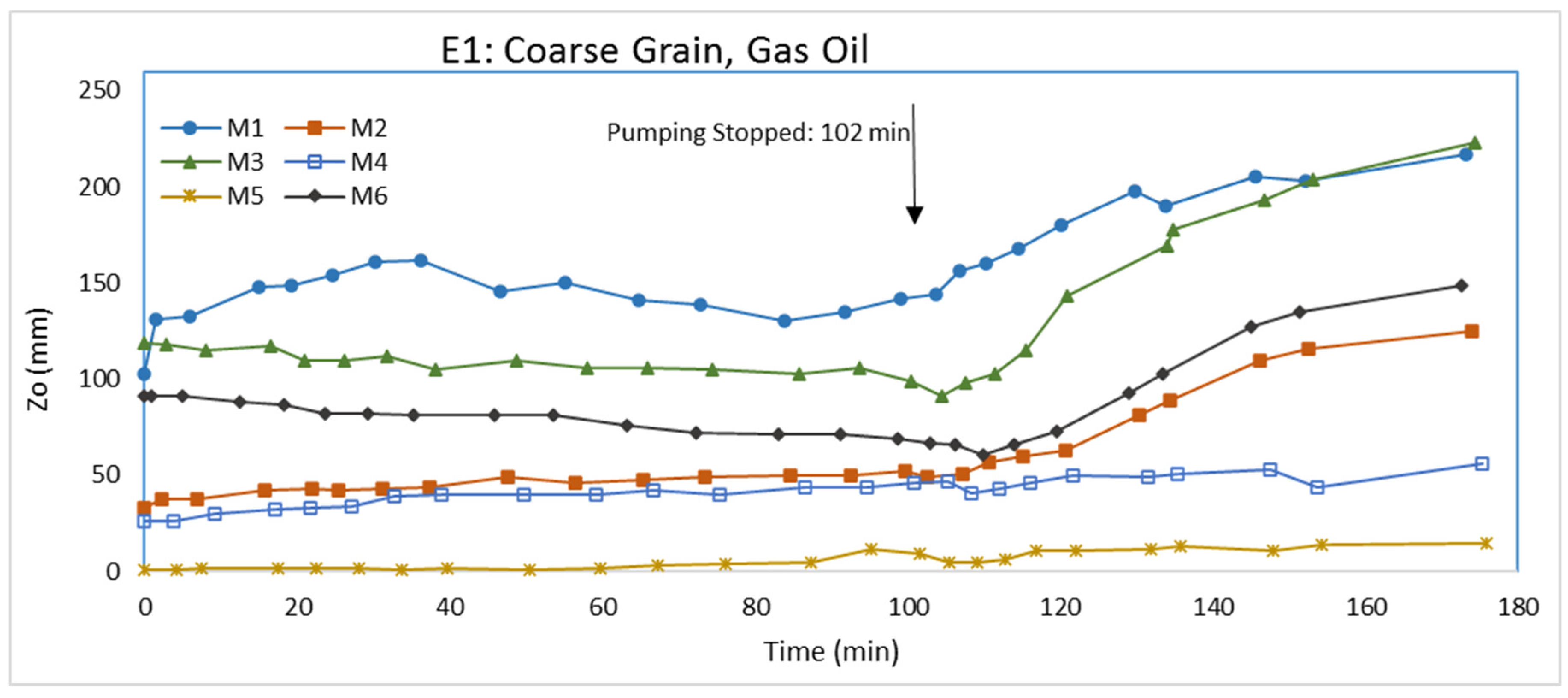
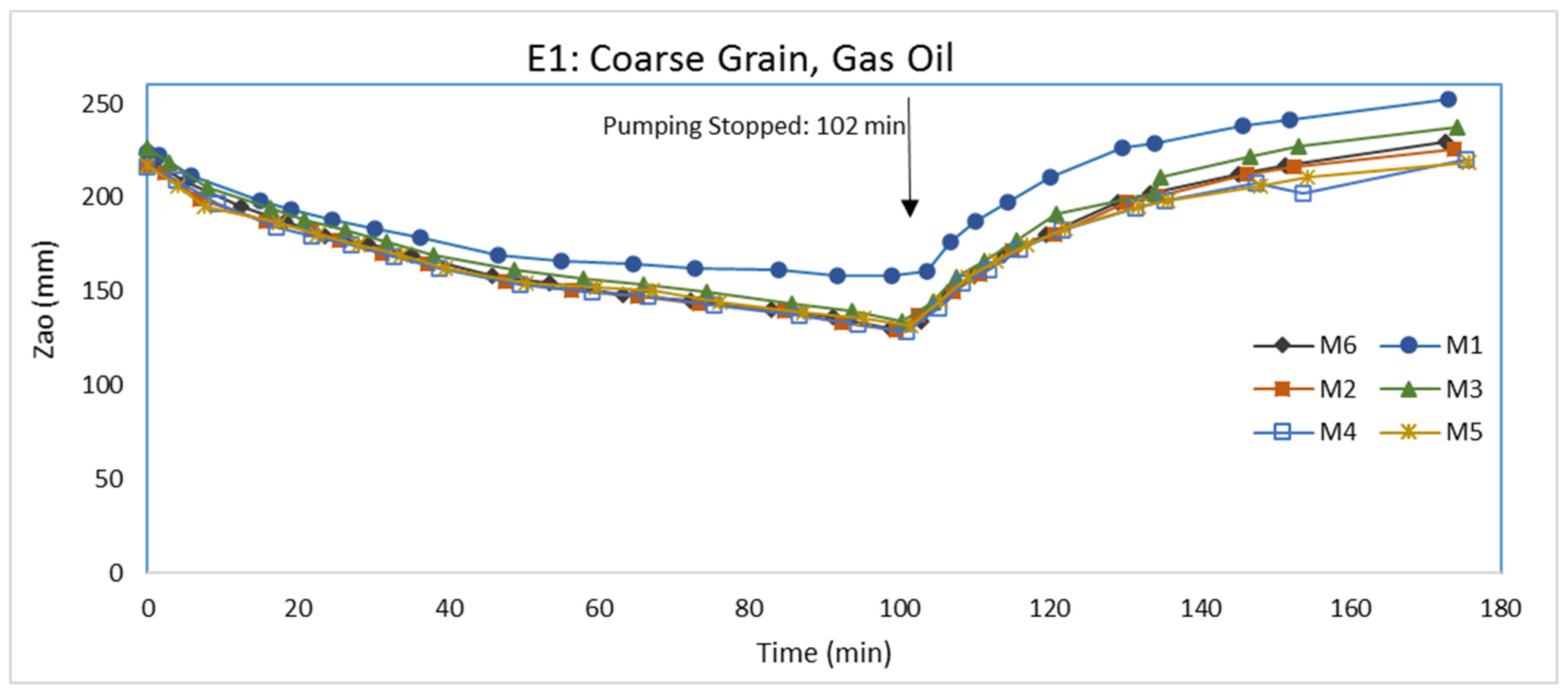
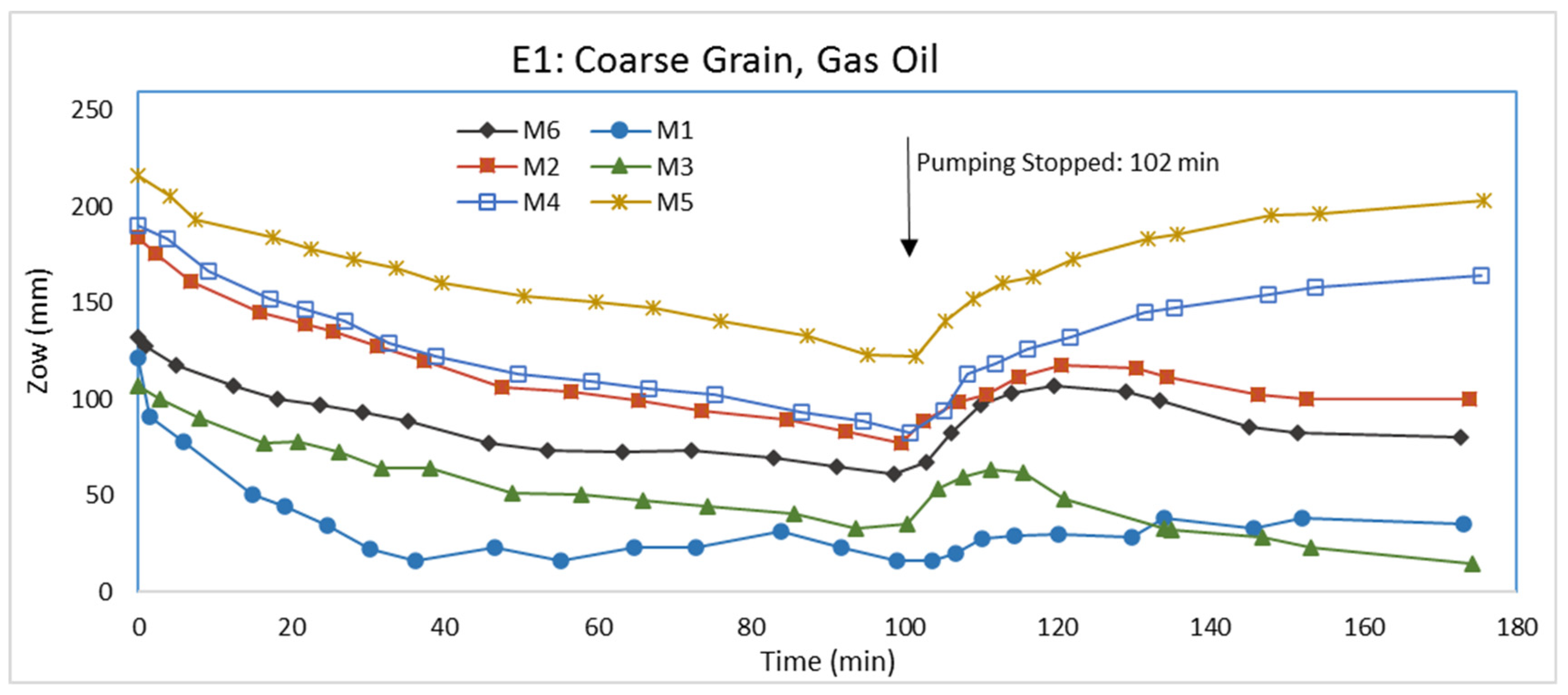


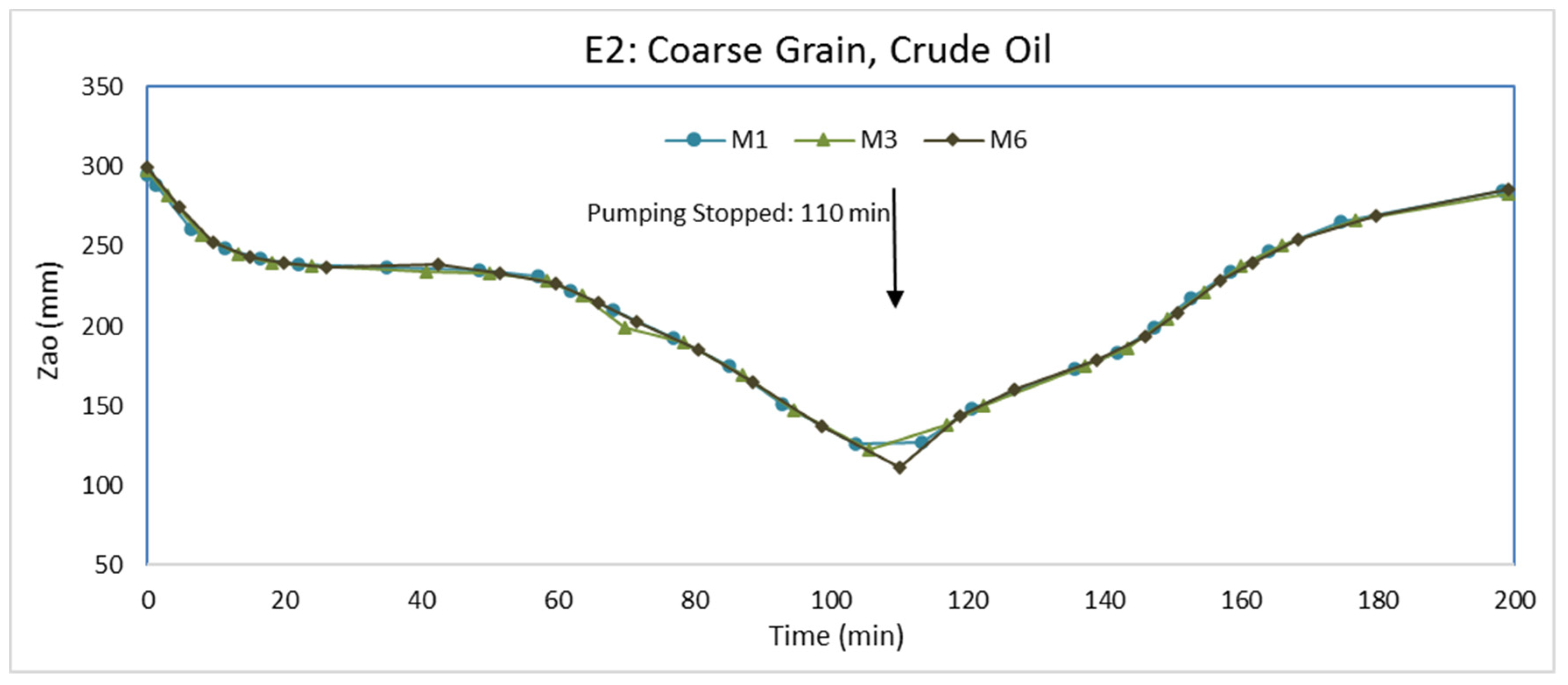
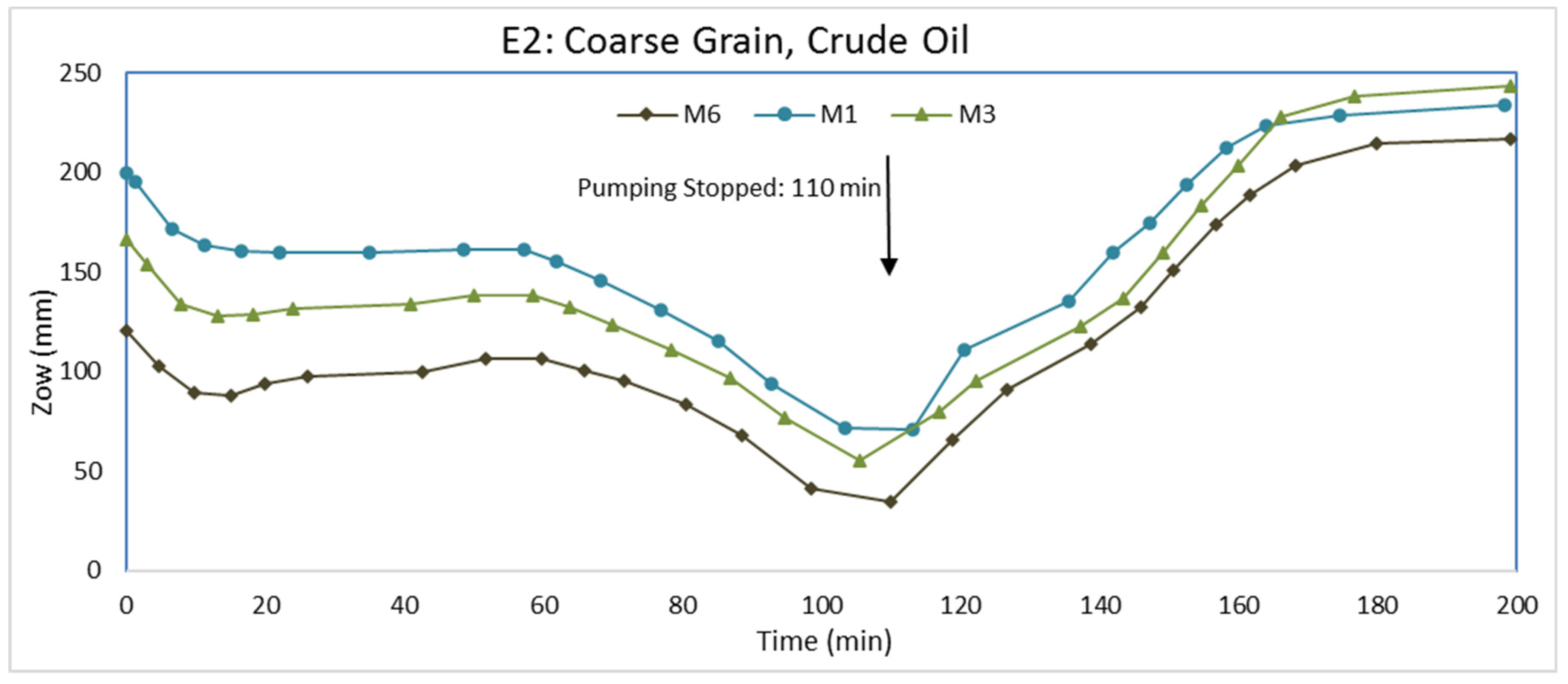
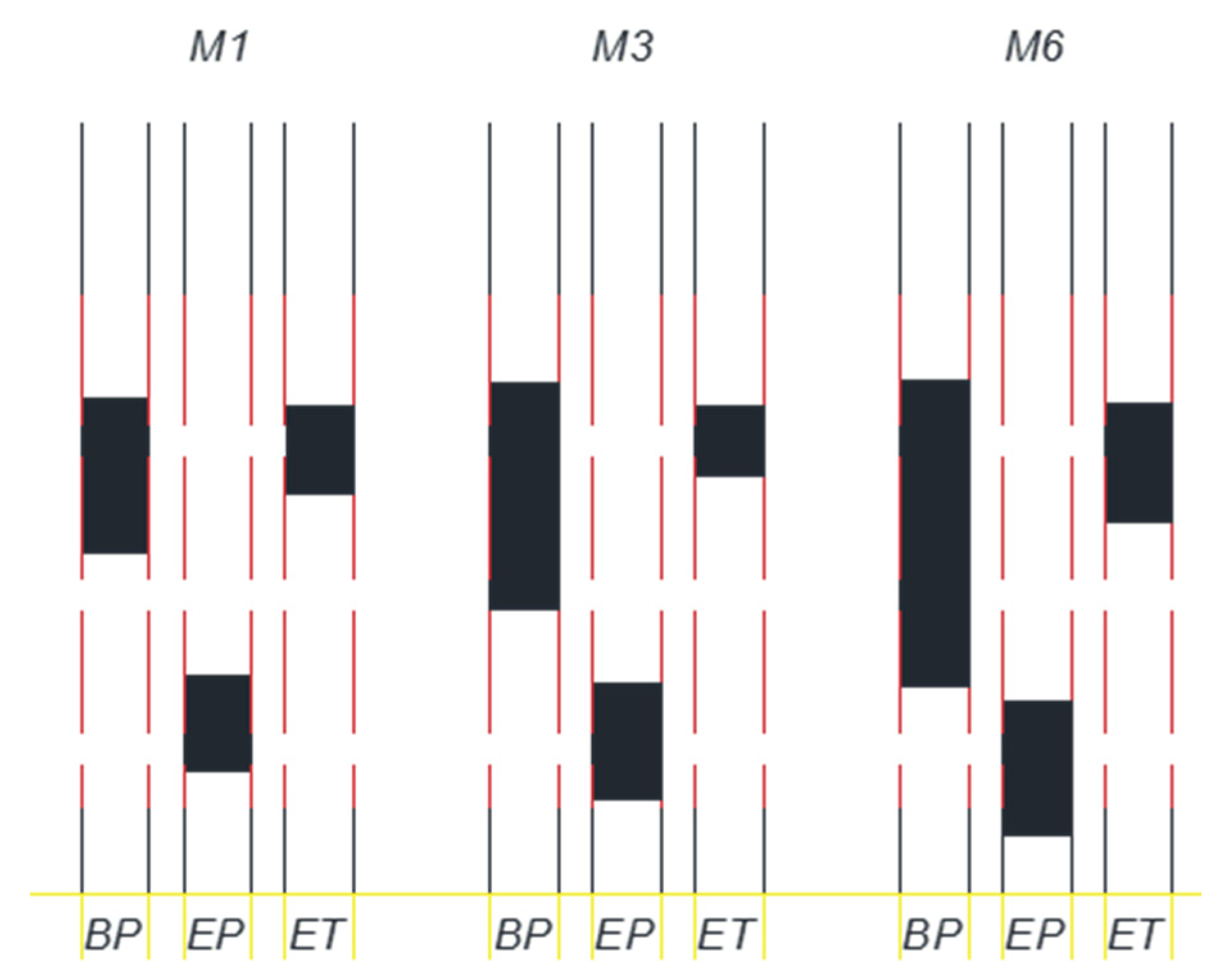
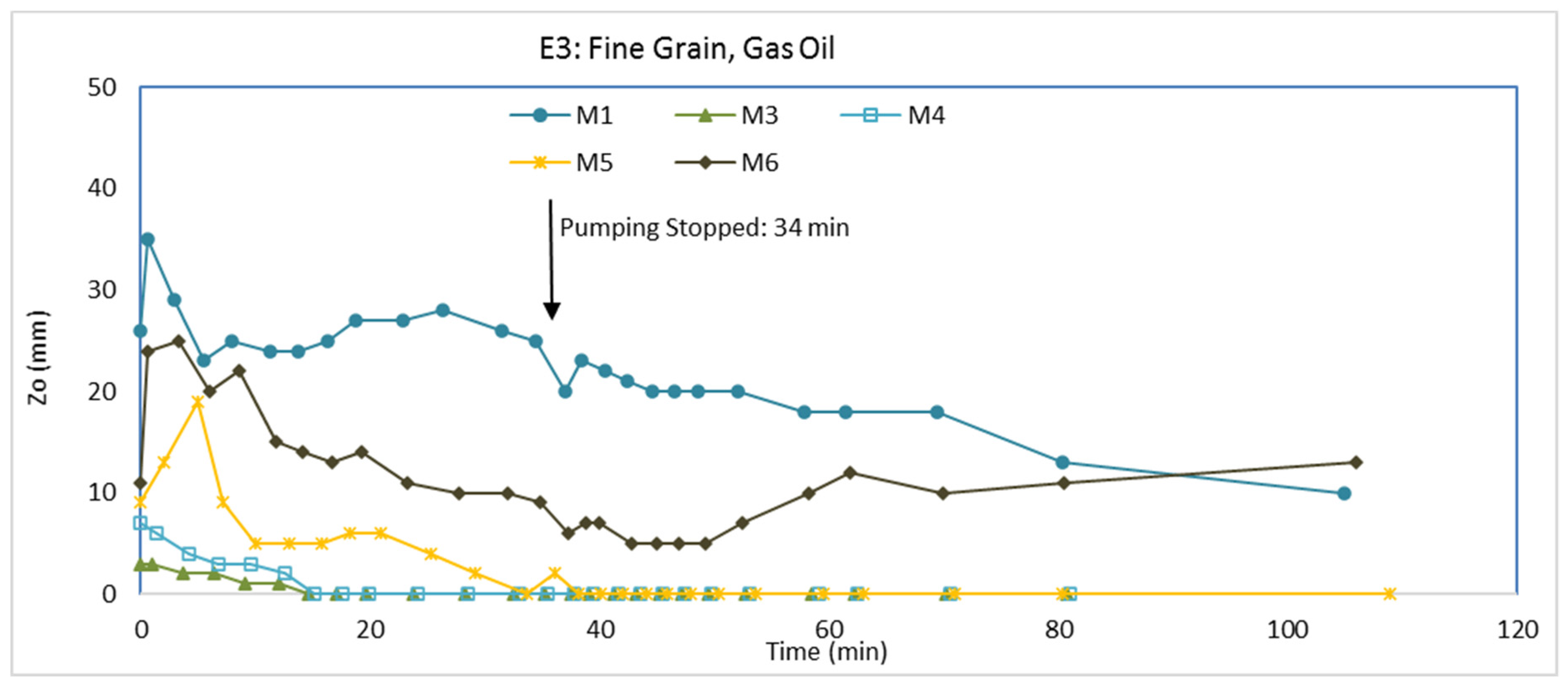
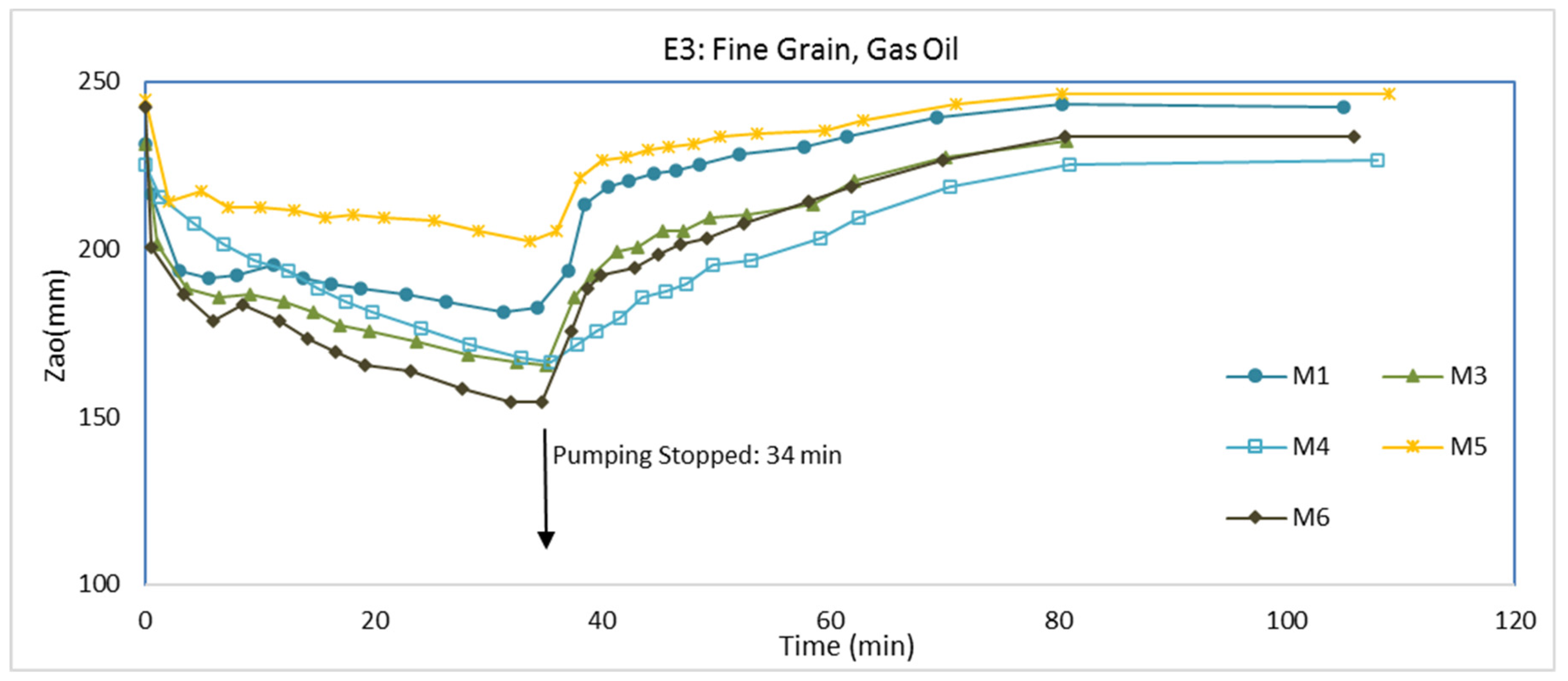
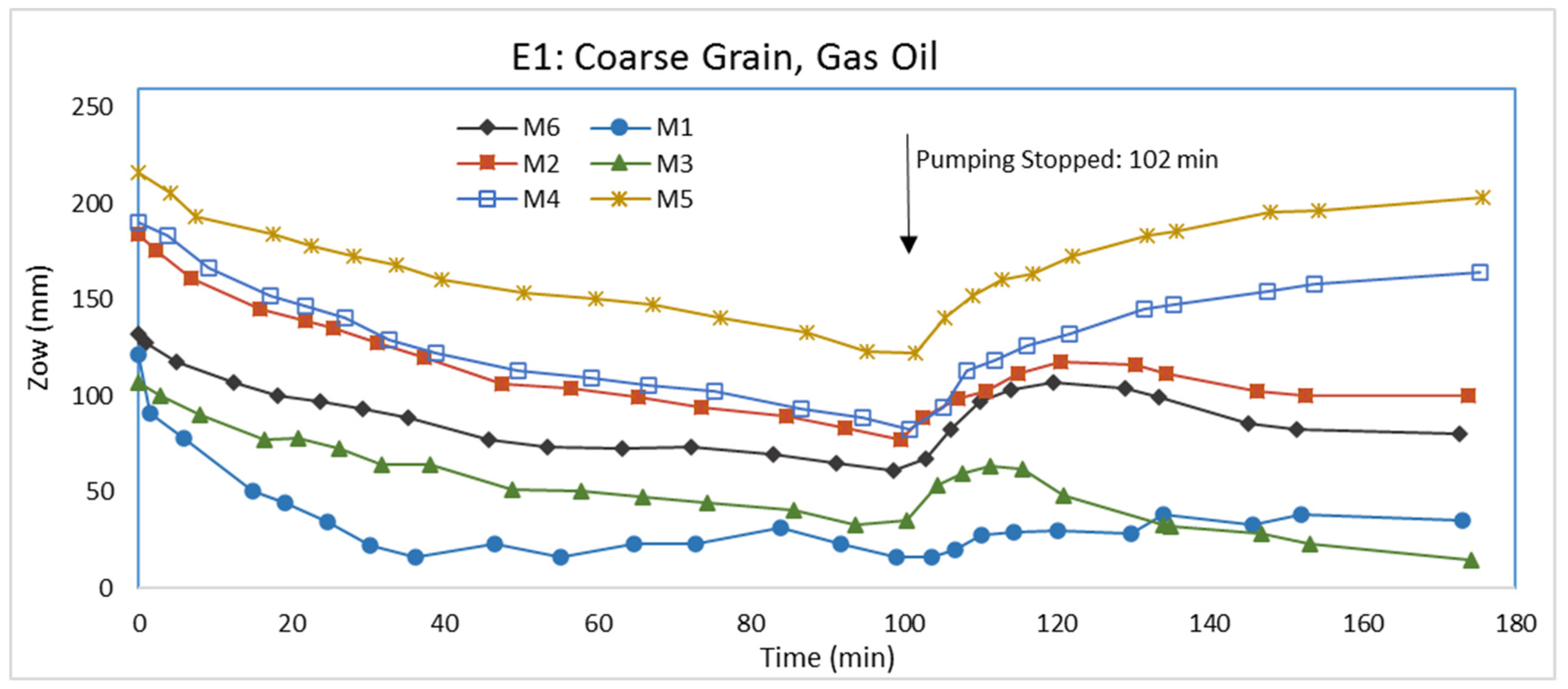

| LNAPL | API | Viscosity (Pa·s) | Specific Weight (kg/m3) |
|---|---|---|---|
| Crude Oil | 31.5 | 0.0230 at 10 °C 0.0140 at 20 °C | 868.2 |
| Gas Oil | 39.2 | 0.0017 at 50 °C | 829.0 |
| Exp. No. | LNAPL | Grain Size (μm) |
|---|---|---|
| E1 | Gas Oil | Coarse grain (400–750) |
| E2 | Crude Oil | Coarse grain (400–750) |
| E3 | Gas Oil | Fine grain (<125) |
© 2020 by the authors. Licensee MDPI, Basel, Switzerland. This article is an open access article distributed under the terms and conditions of the Creative Commons Attribution (CC BY) license (http://creativecommons.org/licenses/by/4.0/).
Share and Cite
Azimi, R.; Vaezihir, A.; Lenhard, R.J.; Hassanizadeh, S.M. Evaluation of LNAPL Behavior in Water Table Inter-Fluctuate Zone under Groundwater Drawdown Condition. Water 2020, 12, 2337. https://doi.org/10.3390/w12092337
Azimi R, Vaezihir A, Lenhard RJ, Hassanizadeh SM. Evaluation of LNAPL Behavior in Water Table Inter-Fluctuate Zone under Groundwater Drawdown Condition. Water. 2020; 12(9):2337. https://doi.org/10.3390/w12092337
Chicago/Turabian StyleAzimi, Reza, Abdorreza Vaezihir, Robert J. Lenhard, and S. Majid Hassanizadeh. 2020. "Evaluation of LNAPL Behavior in Water Table Inter-Fluctuate Zone under Groundwater Drawdown Condition" Water 12, no. 9: 2337. https://doi.org/10.3390/w12092337
APA StyleAzimi, R., Vaezihir, A., Lenhard, R. J., & Hassanizadeh, S. M. (2020). Evaluation of LNAPL Behavior in Water Table Inter-Fluctuate Zone under Groundwater Drawdown Condition. Water, 12(9), 2337. https://doi.org/10.3390/w12092337







